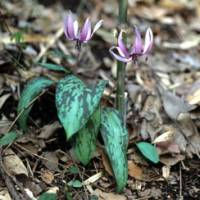Species: Dogtooth violet
Status: Classed as "vulnerable" or "endangered" in some prefectures During the last Ice Age 20,000 years ago, western Honshu was covered in mixed deciduous and conifer forests that provided an ideal habitat for the katakuri (Dogtooth violet; Erythronium japonicum). These plants that produce dainty mauve flowers in early spring grow only where sunlight reaches the forest floor, blooming before leaves block out the sun from overhead. Back when mammoths and moose roamed Japan, such habitat was abundant. But as the archipelago warmed, evergreen broadleaf trees such as the shii (chinquapin) and varieties of kashi (evergreen oak) replaced conifers, nara (deciduous oaks) and buna (beech) trees from the Kanto region westward. Since these were leafy year-round, Dogtooth violets could no longer grow below them.
Luckily, a refuge was in sight: satoyama woodlands. These secondary forests were made up of deciduous trees and so provided islands of habitat similar to what prevailed during the Ice Age. Not only the Dogtooth violet, but other species not found in evergreen forests — such as the Gifu butterfly — could survive in western Japan long after their natural habitat had shifted northward. But now, as the composition of abandoned satoyama woodlands changes, these species are again seeing their habitat diminish.

















With your current subscription plan you can comment on stories. However, before writing your first comment, please create a display name in the Profile section of your subscriber account page.